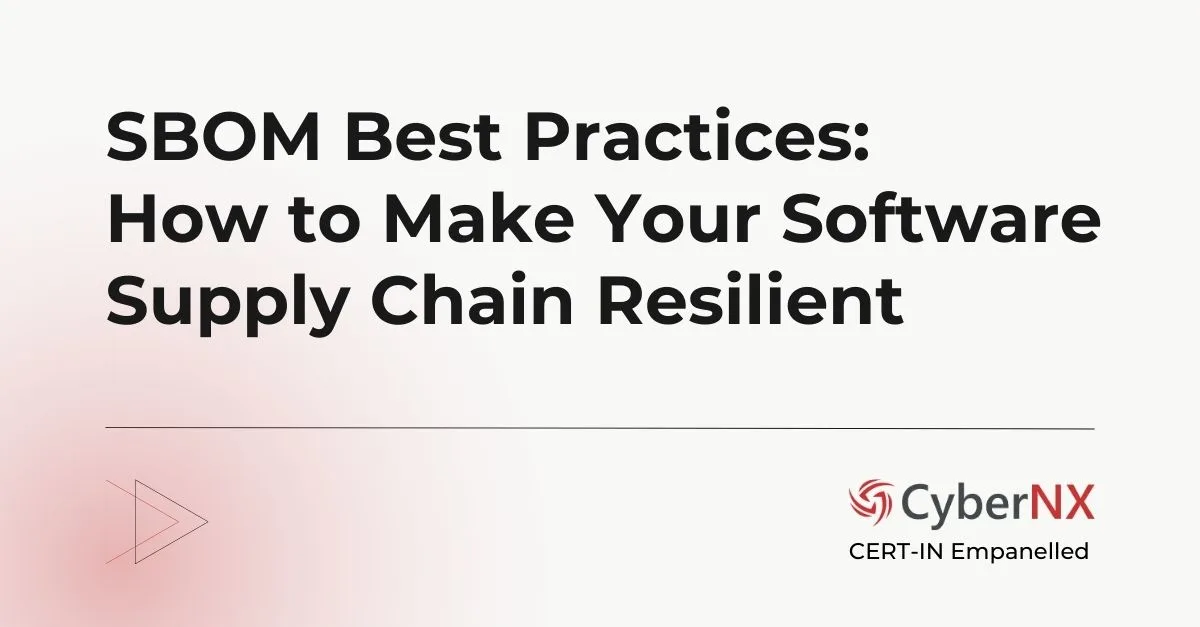Software is running the world. But while building all-important programs, applications or package, the developers often use open-source and third-party code libraries. But how do you know all the existing codes are safe? A Software Bill of Materials (SBOM) shows you exactly what’s inside your software applications.
But here’s where things get tricky. Even though SBOMs sound simple on paper, many businesses are fumbling when it comes to using them correctly. And those slip-ups are costing organizations money, time, and sometimes their reputation.
Let’s untangle the common SBOM mistakes you should avoid in 2025.
What is SBOM?
An SBOM, or Software Bill of Materials, is a detailed inventory of all the components that make up a piece of software – open-source libraries, dependencies, third-party modules, and everything in between. Think of it as a map of your software supply chain.
Why does it matter? Because software today is rarely built from scratch. It’s assembled, using parts created by different people and organizations. Without an SBOM, you don’t really know what’s in your system. And if you don’t know what’s in it, you can’t properly secure it.
That’s why governments and industries across the globe are pushing for SBOM adoption, and it’s quickly becoming mandatory.
Common SBOM Mistakes to Avoid
Even the best security teams slip up when it comes to SBOMs. Let’s break down the mistakes that quietly weaken your defenses and how you can steer clear of them.
1. Treating SBOMs Like a One-Time Project
This one is huge. Some teams treat an SBOM like a compliance checklist. Generate it once, file it away, and sit back to relax. Done, right? Not really.
Software supply chains shift constantly. Open-source libraries get updated, dependencies pile up, and vulnerabilities sneak in like unwanted guests. If your SBOM isn’t living and breathing – kept up to date – you’re not really solving the problem. You’re just giving yourself a false sense of security.
2. Ignoring the Depth of Dependencies
Ever cooked food and realized you forgot the salt? Happens all the time. But in software, that “forgotten salt” can be the deep dependency buried three layers down in your code.
One of the biggest SBOM mistakes is stopping at the surface. Teams map their direct dependencies but miss what lies beneath. That’s dangerous. Attackers love hiding in those hidden layers because they’re harder to track. Your SBOM should shine a light on what you can see and on what’s hiding in the shadows.
3. Using Inconsistent Formats
Different teams in the same company using different SBOM formats. CycloneDX here, SPDX there, maybe even some homegrown spreadsheets floating around. Before long, you get a puzzle with mismatched pieces.
Standardizing on a single format doesn’t just make your life easier. It makes collaboration smoother, compliance simpler, and automation possible. Otherwise, you’re setting yourself up for frustration when you try to merge or analyse across systems.
4. Forgetting to Validate the SBOM
This is where confidence can betray you. You generate an SBOM, feel proud, and assume it’s accurate. But here’s the truth – sometimes the tools misreport, dependencies get skipped, or data gets corrupted along the way.
One of the SBOM mistakes is not validating the output. Always check it against your codebase. Think of it like proofreading your work before submitting it. It saves you embarrassment, but more importantly, it saves you from leaving critical vulnerabilities untracked.
5. Keeping SBOMs Locked Away
Sharing SBOMs feel risky. What if competitors learn too much? What if vulnerabilities become public? But hoarding SBOMs behind locked doors is another mistake.
Transparency is part of why SBOMs exist. Regulators, partners, and even customers want visibility. Controlled sharing – done the right way – builds trust. And when done securely, it doesn’t expose you. Instead, it shows you’re serious about security and accountability.
6. Overcomplicating the Process
Teams spin up massive SBOM projects with too many tools, too much jargon, and endless dashboards. Before long, the process is so complicated no one wants to maintain it.
Sometimes the simplest approach is the best one. Pick a reliable SBOM tool. Integrate it into your CI/CD pipeline. Automate updates. That’s it. Keep it lean, clear, and practical.
How SBOM Mistakes Can Hamper Your Business
SBOM mistakes might seem small at first, but they can quietly erode your business from the inside. An outdated or incomplete SBOM can hide vulnerabilities that attackers exploit, leading to breaches, downtime, and compliance failures. Even worse, poor SBOM practices can stall product releases, strain relationships with regulators or clients, and chip away at customer trust. In today’s transparency-driven market, accuracy isn’t optional – it’s a reputation safeguard. Getting your SBOM wrong doesn’t just put your software at risk; it puts your entire brand credibility on the line.
Best Practices for SBOM Generation
The key to avoiding common SBOM mistakes is to make SBOM generation simple, automated, and consistent.
Start by integrating SBOM tools directly into your CI/CD pipeline so every new build produces a fresh, accurate inventory. Use standardized formats like SPDX or CycloneDX to ensure compatibility across teams and systems. Validate regularly to catch missing dependencies early. And don’t forget documentation – clearly outline how SBOMs are created, reviewed, and shared.
When generation becomes part of your normal development rhythm, your SBOMs stop being a chore and start becoming a strength.
We have covered SBOM Best Practices exhaustively in one of our previous blogs. Read now
How to Manage SBOM?
Avoiding SBOM mistakes is only half the story. You also need a plan for managing them effectively:
- Automate generation and updates: Build SBOM creation into your CI/CD pipeline so it refreshes with every new build.
- Centralize storage: Keep SBOMs in one place where they’re easy to access, review, and share with stakeholders.
- Validate regularly: Double-check the accuracy of SBOMs with automated scans and manual reviews.
- Use trusted formats: Stick with standardized formats like SPDX or CycloneDX for consistency.
- Set access rules: Share SBOMs securely with regulators, customers, or partners to build trust without losing control.
The goal isn’t to make SBOMs perfect. The goal is to make them useful, usable, and reliable.
Conclusion
SBOMs aren’t just about compliance – they’re about clarity. They help you see what’s in your software, where the risks are, and how to fix them. But falling into these SBOM mistakes – treating it as one-and-done, ignoring dependencies, mixing formats, failing to validate, hiding them away, or overcomplicating things – can derail all that effort.
Most companies are still figuring this out. Start small. Stay consistent. And remember: just like checking the ingredients before you cook, the little habit of maintaining a clean, accurate SBOM pays off in the long run.
CyberNX’s in-house built SBOM management tool offers deep visibility to components, automates SBOM generation and secures your software. Get in touch with our experts to discover how we can strengthen your software supply chain.
SBOM Mistakes FAQs
Why are SBOMs becoming more important in 2025?
With rising software supply chain attacks and new regulatory mandates, SBOMs are no longer optional – they’re a critical part of demonstrating software transparency and trustworthiness.
Can small businesses also make SBOM mistakes, or is this mainly a big enterprise issue?
Absolutely, small businesses face the same risks. In fact, without dedicated security teams, they’re more likely to overlook SBOM maintenance and validation.
What tools can help prevent common SBOM mistakes?
Tools like NXHawk, Syft, CycloneDX, SPDX-compatible scanners, and CI/CD-integrated solutions help automate generation, validation, and updates, reducing human error.
How often should an SBOM be updated?
Ideally, with every new build or release. At the very least, update quarterly to ensure vulnerabilities and dependencies are tracked accurately.






